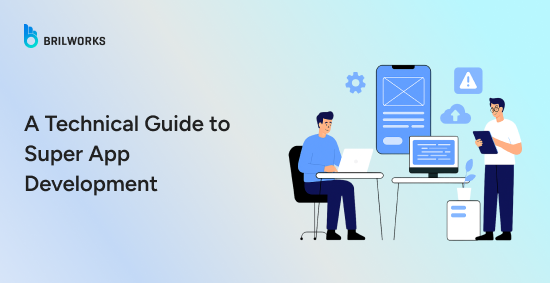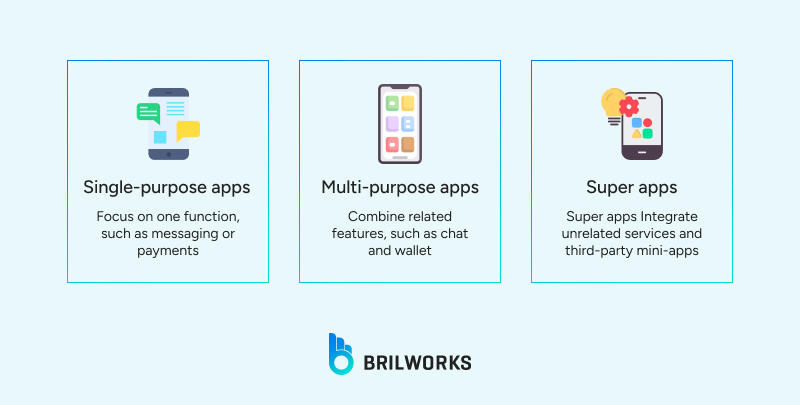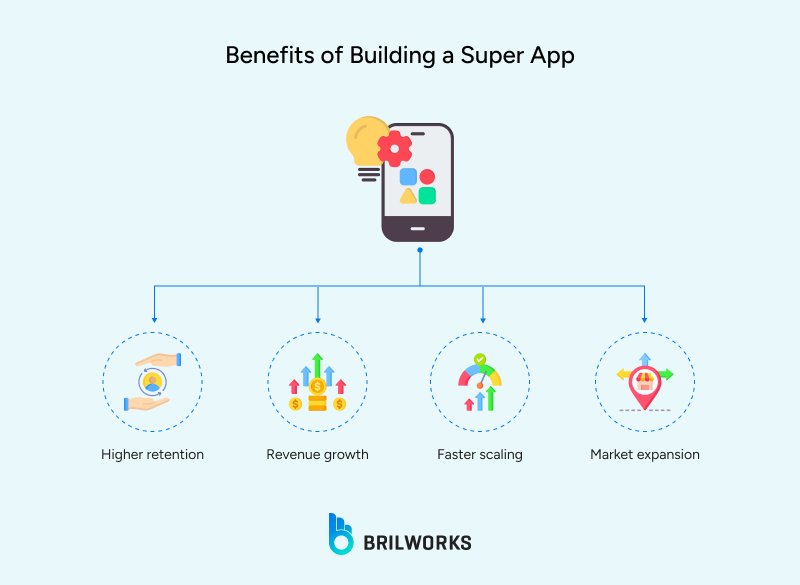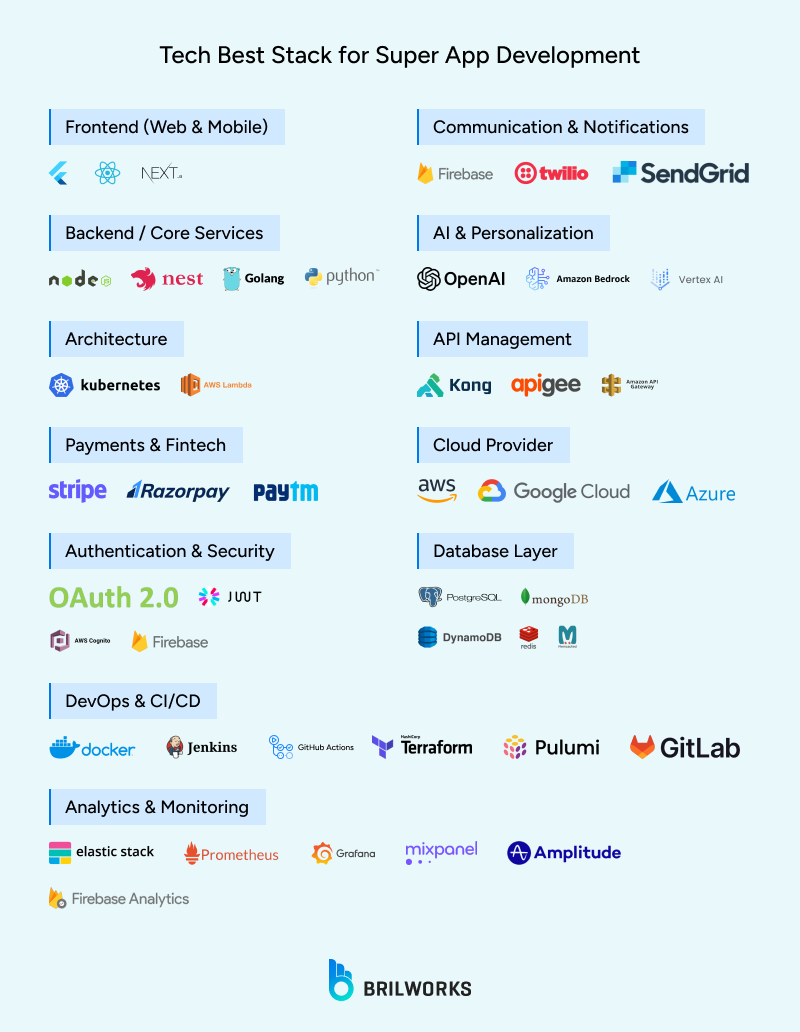COOPERATION MODEL
ARTIFICIAL INTELLIGENCE
PRODUCT ENGINEERING
DevOps & Cloud
LOW-CODE/NO-CODE DEVELOPMENT
FRONTEND DEVELOPMENT
CLOUD DEVELOPMENT
MOBILE APP DEVELOPMENT
LOW CODE/ NO CODE DEVELOPMENT
EMERGING TECHNOLOGIES








A super app brings together many digital services, or mini apps, into one platform. Instead of switching between different apps for messaging, payments, shopping, or delivery, users can do it all in one place. WeChat, Alipay, and Gojek are top examples.
According to a report, super apps are expected to enter the B2B space soon. And by 2031, the super app market could reach USD 874.64 billion, nearly double its 2024 value.
Super apps evolved as user expectations shifted from single-use tools to connected experiences. Early mobile apps have limited capabilities. But as smartphones became central to daily life, people started preferring platforms that could handle multiple needs at once.
Companies that recognized this early began layering additional services onto their core product. A payment app added ride bookings, a chat app introduced shopping, and over time, these evolved into multifunctional ecosystems.
Let’s take a brief look at what the difference is between single-purpose and multi-purpose. And if super apps are different from multi-purpose apps.

Super apps are a smart business move. Bringing all services into one app helps keep users engaged, lowers costs, and opens up new ways to earn revenue.

From a development point of view, the microservices setup ensures that each module can be built, updated, and scaled separately. For example, if the payment system needs an update, it can be deployed independently without affecting chat or delivery modules.
By combining containerization, event-driven systems, and automated CI/CD pipelines, teams can manage releases more safely and efficiently.
At the heart of every super app is a layered architecture that balances flexibility, performance, and security. It typically includes five main components that work together.
This is the foundation. Each service is responsible for a single function — authentication, payments, notifications, or search. The isolation between services allows for easier debugging and independent scaling. Common choices for backend development include Node.js, Golang, and Spring Boot.
The API gateway manages traffic between internal and external services. It routes requests, applies authentication, and enforces rate limits. Technologies like GraphQL, REST, and gRPC are often used to create consistent and secure communication channels.
Super apps host smaller “mini-apps” or modules that extend functionality. These are developed using SDKs and can be maintained by external partners. The mini-app framework defines permissions, access control, and interface rules so the experience stays consistent.
A strong data system powers personalization, recommendations, and insights. Super apps use streaming data pipelines, cloud-based warehouses like BigQuery or Redshift, and real-time dashboards to monitor engagement and behavior patterns.
Handling transactions and user data across multiple services requires strong security measures. Secure authentication (OAuth 2.0, JWT), end-to-end encryption, and API-level access control help maintain compliance with privacy and payment regulations.
This is the single most critical phase and the most common point of failure. Teams hear "microservices" and think of small, decoupled services. But for a super app, that's not enough. You must think of your core architecture as an internal Platform-as-a-Service (PaaS) from day one.
If you start with a "core module" (like payments) and then "break it out" into microservices later. This fails. You'll end up with a "distributed monolith."
Here is a different approach you can take. Before writing a single line of the "core feature," you build the Platform Foundation. This foundation is the product. It consists of:
The Identity Service: The single source of truth for a user. This service only handles authentication, authorization, and core profile data. It knows nothing about payments, rides, or food.
The Wallet Service: The transactional core. It manages ledgers, stored value, and payment instruments. It exposes APIs for "debit" and "credit" and is obsessively secure.
The Governance Bus: An asynchronous event bus (like Kafka or Pulsar). This is the central nervous system. When a user signs up, the Identity Service emits a user.created event. Other services listen to this—the Wallet service creates a wallet, the loyalty service creates an account—without the Identity service even knowing they exist. This enforces true decoupling.
Your first feature team (e.g., "Payments") must be your first customer. They must build their feature by only consuming this internal PaaS, just as a third-party partner would.
Tools like Docker, Kubernetes, and AWS are just the basics. You must embrace a polyglot stack. The most important stack choice is not the language but the API Gateway and Service Mesh. This layer becomes your unified "front door."
It handles service discovery, mTLS (mutual-TLS security), rate limiting, and request tracing before a request ever hits a mini-app's service. This is what allows 50 different teams, writing in 5 different languages, to coexist without chaos.

This step is fundamentally misunderstood. You are not just building the first user-facing feature. You are simultaneously building the "Shell" (the main app) and the SDK (Software Development Kit) that allows features to run inside the shell.
The "Payments" feature must be built as the first mini-app. Your internal team must use the exact same SDK and APIs that you plan to give to third-party developers. This is "dogfooding," and it's non-negotiable.
This isn't a separate step; it's the deliverable from step 3. The generic description, however, misses the most critical component. The SDK's most important job is to create a Sandbox Runtime inside the mobile app. A mini-app (from a third party, or even your own "Food" team) must never be allowed to:
Read files from the device directly.
Access the user's contacts, location, or camera without explicit permission brokered by the SDK.
Make arbitrary network calls to its own servers.
This is less a development task and more a governance and product management one. You need a Mini-App Review Pipeline, just like the Apple App Store. Our agency has built these for clients. This is an automated pipeline that:
Scans the mini-app's code bundle for blacklisted code (e.g., "eval()", or calls to private APIs).
Verifies the manifest to ensure the permissions it requests (e.g., "location") are justified by its business function.
Deploys it to an internal "App Store" where QA can test it on-device.
Publishes it, at which point the super app's "Discovery" service can now list it, making it "live" for users without requiring a full app store update.
The generic description (CI/CD, Prometheus) is fine for a single service. For a super app, it's dangerously insufficient.You must implement Distributed Tracing and Business Observability from Day 1.
Distributed Tracing (using OpenTelemetry, Jaeger, or DataDog APM) is mandatory.
Your dashboards shouldn't just show http_500_errors. They must show failed_payment_attempts_by_merchant, user_signup_funnel_completion_rate, and mini_app_load_time_p95.
Throughout the process, DevOps practices play a central role. Continuous integration, automated testing, and rolling updates keep deployment stable even as new services are added.
Super apps can grow quickly, but they also add complexity. Coordinating multiple services, teams, APIs, and infrastructure can be challenging without a solid system.
Scalability issues arise when one service grows faster than others. Without elastic cloud resources, performance may drop under heavy traffic.
Integration challenges happen when APIs are inconsistent or when third-party services use different data formats. A well-structured gateway and version control can reduce these risks.
Security becomes more critical as more modules handle sensitive data. Proper encryption, token-based access, and traffic monitoring help avoid breaches.
User experience is another challenge. With too many features, the interface can become confusing. Modular design systems and frontend frameworks like React Native or Flutter help maintain a clean, consistent layout.
The key is to design for growth. Each component should be able to evolve independently while maintaining smooth interaction with others.
Super apps are still evolving. In the next few years, their growth will be driven by technologies that make them even more intelligent, connected, and user-centric.
AI-driven personalization will shape how content and services are presented. Machine learning models will predict what users need next, improving engagement.
Cloud-native infrastructure will remain the standard for scalability and cost efficiency, with growing adoption of serverless computing for lightweight tasks.
Cross-platform development using Flutter, React Native, or Progressive Web Apps (PWAs) will help reach wider audiences faster.
API ecosystems will expand as more developers build plug-ins and mini-apps, turning super apps into open platforms rather than closed systems.
Enhanced security with zero-trust frameworks and decentralized identity management will become essential as super apps handle finance, health, and personal data.
Building a super app takes time and careful planning. You need a solid technical foundation, the right tools, and a clear plan for growth. Use microservices, APIs, and cloud platforms to keep everything modular and scalable. Implement DevOps automation, real-time analytics, and user-focused design to keep quality consistent as you grow.
Super apps are changing the way people use technology. They offer convenience, build loyalty, and create new business opportunities, but only if they are built on a strong technical base. With the right approach and tools, you can build a platform that grows and succeeds in today’s connected world.
Get In Touch
Contact us for your software development requirements
Get In Touch
Contact us for your software development requirements